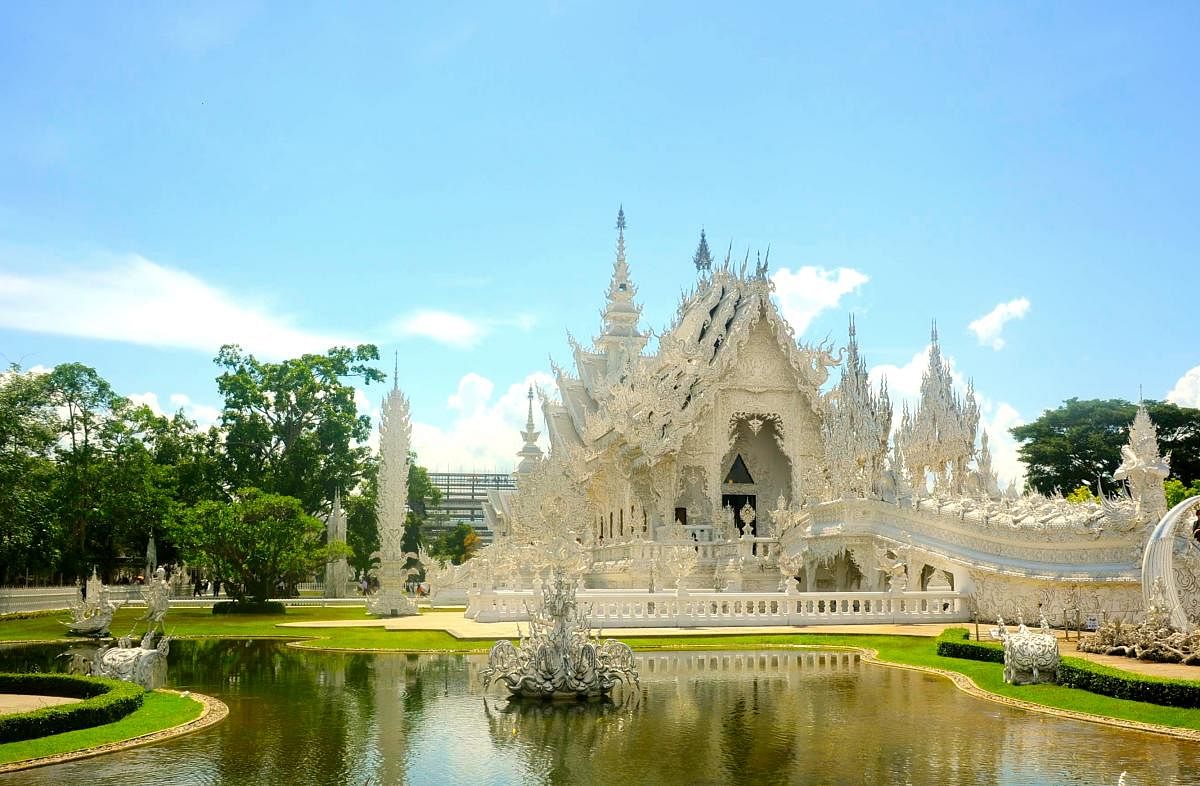
The Black House? The White Temple? The Blue Buddha? The Golden Clock Tower? Or, the brown Bamboo Buddha?” In Northern Thailand’s Chiang Rai, Wilaiwan Soison, the guide, was throwing choices off the palette. I knew the country’s weekly lucky/unlucky colour code: Sunday: red (say no to blue), Monday: yellow (no red), Tuesday: pink (no yellow & white)… Wait, Wednesdays in Thailand are colour-complicated. There’s green for the day, grey for the night, no pink in the daytime and no orange-red at night.
One for each day
“You are colour-coded today. It’s Saturday, you are wearing black. So, let’s go to the Black House,” Soison dragged me out of the colour roulette and the car meandered through lush villages and screeched in front of the Black House of artist Thawan Duchanee. I knew not much about Duchanee, the country’s national artist who has created the Museum of Folk Art in his home town. Thankfully, I was not in my kitten heels because the museum is a long walk around 40 black houses made of wood, concrete, bricks, terracotta that accommodate Duchanee’s personal collection of art from around the world. Not just art, but animal bones, skins, chairs made of buffalo horns, ladles with phallic ends.
From the morbid mastery of black, I took a monochromatic turn into the silvery, shiny, sheeny, satiny white of the White Temple, Chiang Rai’s most-seen monument. In the afternoon sun, the white temple stood as a polished jewel against the blue sky. Built by living artist, Ajarn Chalermchai Kositpipat, who vowed to “build the most beautiful temple in the world,” it is a stark contrast from the oft-repeated golden of Thai wats (temples).
Chalermchai confesses he chose the white to walk away from the cliched. “Golden is suitable for people who lust for evil deeds. White is a representation of the Buddha’s purity and the use of small mirrors throughout the temple is a symbol of wisdom (dhamma) of the Buddha that shines throughout the universe,” the artist delineates his choice of white.
The walls of the main hall are painted, borrowing narratives not from the jatakas but with demons that have George Bush and Osama Bin Laden inside them. Chalermchai is making a vehement statement about how “the world is being destroyed by those who craved to build weapons.”
In the White Temple, my thoughts strayed from Buddha to the evils that threaten the modern world. Chalermchai has a point but he is not finished yet. With the foundation laid in 1997, the artist insists that it will take another 80-90 years to complete the temple. Much after his death.
Tick-tock
The evening was still far away when Chalermchai Golden Clock Tower chimes and changes colours against the inky night. After black and white, it was time for the blues. The blues of Wat Rong Seua Ten, the Blue Temple. Built on the ruins of a temple abandoned nearly a century ago, it borrows its name from dancing tigers (Suea Ten) — from the tigers who used to jump over the Mae Kok river. At the entrance are gigantic dragons and the main hall has an impressive series of tall columns embellished with beautiful motifs. The main Buddha idol is white and at his feet sit sculpted mythical creatures. The entire temple wears the same shade of indigo, briefly interspersed with golden, green, orange and white.
There was the emerald green Buddha at Wat Phra Kaew, which is famous as the original home of the translucent green Buddha which graces the Emerald Buddha Temple in Bangkok’s Grand Palace. But I have seen the Emerald Buddha in Bangkok, so I skipped the green for the brown bamboo Buddha, the largest woven Buddha in Thailand. Known as ‘Phra Sing San Chana Man’, the entire temple is made of woven bamboo. A giant white sculpted elephant stands at the entrance and the devout have left behind bamboo fans on the trellis. I prefer the quiet and the simplicity of the brown to the adornments of the whites and blues in Chiang Rai.
That, however, was not the end of colours in Chiang Rai. The golden was yet to unfold. For that, I had to wait until 7 pm when the clock tower turns into an artistic masterpiece — music pipes, parts of the tower move and the golden acquires other hues — purple, red, green, white at definite intervals.
In the Thai colour calendar, brown is for Thursdays and it is not considered unlucky on any day. So, in Chiang Rai, it was brown for me. The brown of the Bamboo Buddha. Solemn. Stately. Serene.